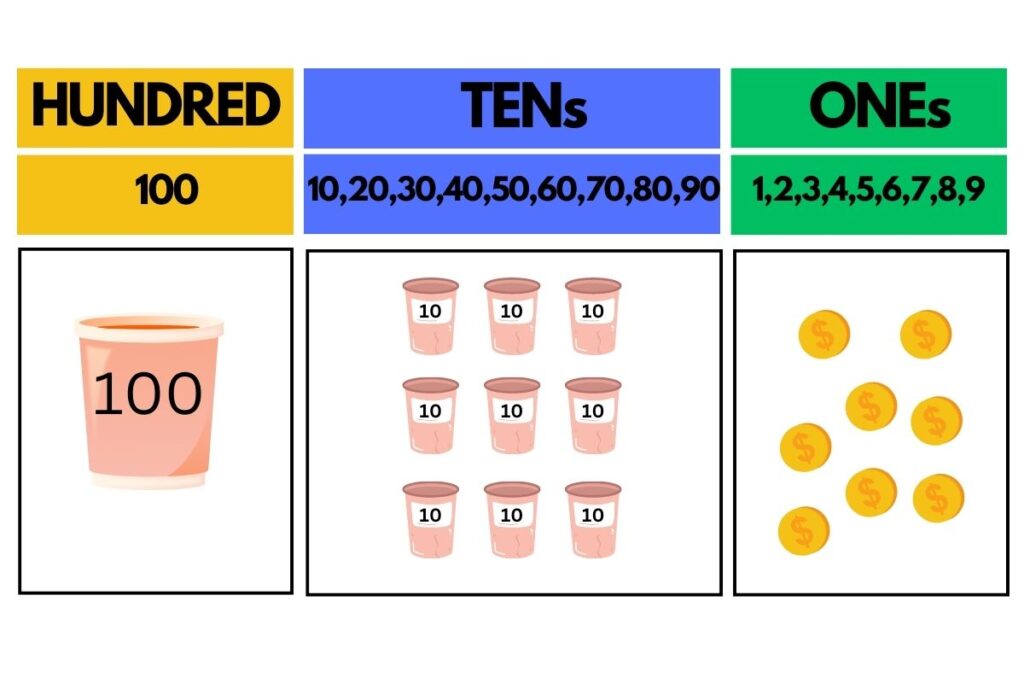Teaching 4-year-old Place Value: Ones, Tens, One Hundred
Teaching kids about place value is an essential concept in mathematics that forms the foundation for understanding larger numbers and performing arithmetic operations. In our curriculum, we encountered a lesson introducing the concept of tens and ones. Despite my daughter’s ability to count up to 100, grasping place value proved challenging. After some research, I stumbled upon an online “Place Value Activity” that sparked an idea for a game using coins. Having previously covered pennies, nickels, dimes, and quarters, we had collected over a hundred pennies in a cup, which led to the creation of the “100 Cents Game.” The game not only facilitated place value comprehension but also reinforced the understanding that there are 100 cents in a dollar.

For this game, we utilized the following materials:
- A large sheet of paper (1.5ft by 3ft), divided into three sections: HUNDRED, TENs, and ONEs
- 11 plastic cups
- A marker to label cups with 10 or 100
- Approximately 110 cents
- Flashcards displaying numbers
The game’s rules are pretty similar to the “Place Value Activity” rules:
- No more than 9 coins in the ONES section
- No more than 9 cups with coins in the TENS section
- The objective is to transfer all 100 coins from a jar to the HUNDREDS section, moving from right to left.

Flashcards with numbers dictated the number of coins to be drawn from the jar. For instance, if the first card displayed the number 4, my daughter would retrieve and position 4 coins in the ONES section.

Then, if the following card revealed 12, she would gather 12 additional coins, raising the total in the ONES section to 16, which is more than 9 and too many for the ONES section (a great way to practice “less than” or “more than” concepts).

Consequently, 10 coins were moved to an empty plastic cup labeled with the number 10, placed within the TENS section. Our score, 10 + 6 = 16, was recorded on the sheet of paper.

When the next card showed 8, we added 8 more coins, causing the total in the ONES section to reach 14. To abide by Rule #1 to not exceed 9 coins in this section, we transferred 10 coins to another labeled cup. We had 2 cups with 10 coins in each and 1 cup with 4 coins.
The score 20 + 4 = 24 was recorded. I showed my daughter how to record the score for the first time and let her do it by herself after.
But what if your child wrote 204 instead of 24? This technique, derived from the “Place Value – Paperfolding activity,” assisted in clarifying that 20 plus 4 equals 24, not 204.

This process of drawing cards and adding coins continued until we reached 9 cups with coins in the TENS section. The final card drawn was an 8, leading to 12 coins in the ONES section. Ten coins were placed in a cup labeled 10, after which we consolidated all 10 cups into one cup labeled 100. Our aim of accumulating 100 coins was achieved, resulting in the following score:
- 100 coins in the HUNDREDS section
- 0 coins in the TENS section
- 2 coins in the ONES section
The cumulative sum amounted to 100 + 0 + 2 = 102.

Afterward, our activity exploring place value led to Base Ten blocks and a couple of curriculum books, which, combined with this creative activity, facilitated my daughter’s grasp of the concepts of ones, tens, and hundreds
Subscribe to our Newsletter
Thank you!
You have successfully joined our subscriber list.